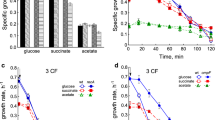Summary
The sensitivity of Penicillium chrysogenum to oxygen starvation and to azide was investigated on cells taken from different phases of a penicillin process. These treatments caused irreversible inhibition of the oxygen uptake rate during the tropophase while the idiophase cells were resistant to either treatment. The azide resistance is supposed to depend only on the dissociation of the hydrazoic acid when the process pH increases, but the shift from sensitive to resistant cells with respect to oxygen starvation was neither caused by the pH-change nor by the glucose limitation. Inactivation (I OUR, percentage) of tropophase cells followed 1st order kinetics according to ln (1-I OUR/100)-1=0.048·t, where t is given in minutes. This means that the 1st minute of oxygen starvation may reduce the metabolic capacity by 4.7%.
Similar content being viewed by others
References
Calam CT (1967) Media for industrial fermentations. Process Biochem June 19–22+46
Enfors SO, Mattiasson B (1983) Oxygenation of processes involving immobilized cells. In: Mattiasson B (ed) Immobilized cells and organelles, CRC Press
Henry MF, Nyns EJ (1975) Cyanide-insensitive respiration. An alternative mitochondrial pathway. Sub-Cell Biochem 4:1–65
Kubicek CP, Zehentgruber O, El-Kalak H, Röhr M (1980) Regulation of citric acid production by oxygen: Effect of dissolved oxygen tension on adenylate levels and respiration in Aspergillus niger. Eur J Appl Microbiol Biotechnol 9:101–115
Longmuir IS (1954) Respiration rate of bacteria as a function of oxygen concentration. Biochem 57:81–87
Mou DG, Cooney CL (1983) Growth monitoring and control in complex medium: A case study employing fed-batch penicillin fermentation and computer-aided on-line mass balancing. Biotechnol Bioeng 25:257–269
Muraoka H, Wataba Y, Ogasawara N (1982) Effect of oxygen deficiency on acid production and morphology of bacterial cells in submerged acetic fermentation by Acetobacter aceti J Ferment Technol 60:171–180
Vardar F, Lilly MD (1982) Effect of cycling dissolved oxygen concentrations on product formation in penicillin fermentations. Eur J Appl Microbiol Biotechnol 14:203–211
Vardar F (1983) Effect of short interruption in aeration on Penicillium chrysogenum and productivity in fermentations. Chimica Acta 53–58
Wang DIC, Fewkes RCL (1977) Effect of operating and geometric parameters on the behaviour of non-newtonian mycelial, antibiotic fermentations. Dev Ind Microbiol 18:39–56
Author information
Authors and Affiliations
Rights and permissions
About this article
Cite this article
Larsson, G., Enfors, SO. Influence of oxygen starvation on the respiratory capacity of Penicillium chrysogenum . Appl Microbiol Biotechnol 21, 228–233 (1985). https://doi.org/10.1007/BF00295127
Received:
Issue Date:
DOI: https://doi.org/10.1007/BF00295127




